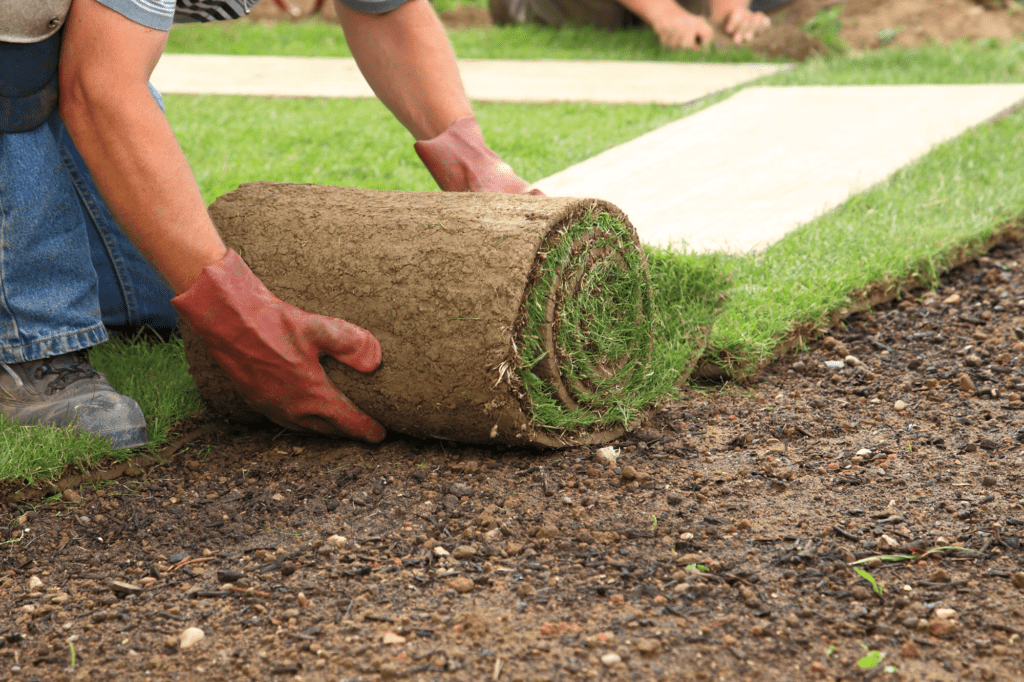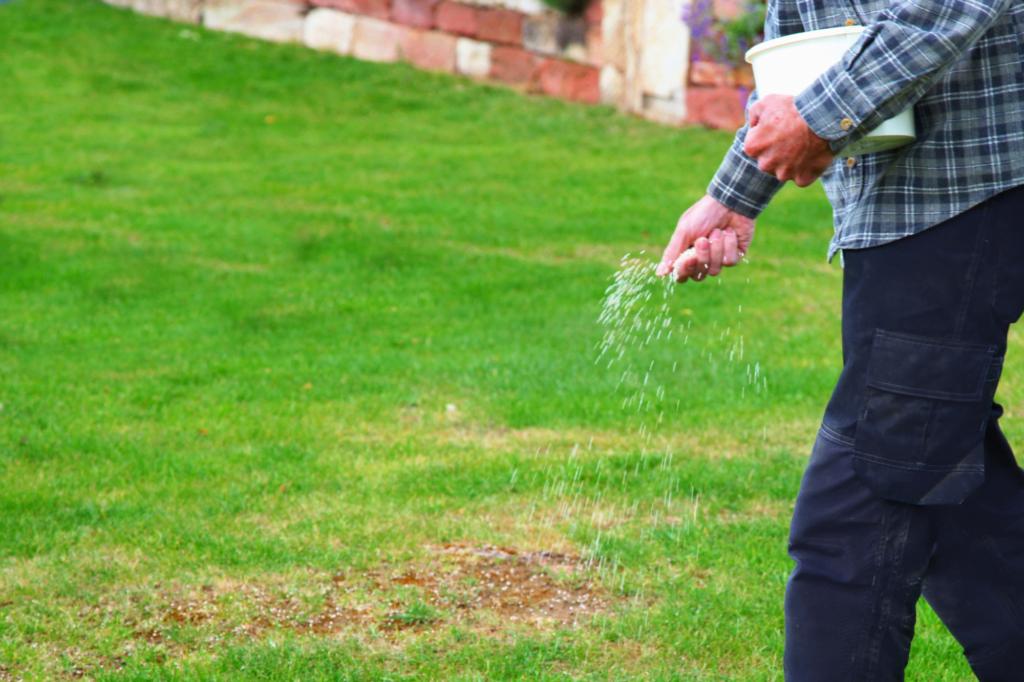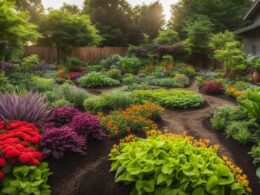Quick Summary
- Assess the damage and remove debris from the yard after removing the above ground pool.
- Fill in any holes with soil and level the area before reseeding or laying new sod.
- Implement regular maintenance practices such as watering, fertilizing, mowing, weeding, and trimming.
- Consider enhancing the yard’s aesthetics by adding flowerbeds, shrubs, pathways, or patio areas, and using pool pads or mats for protection.
Assess the Damage
The first step in repairing your yard after the above ground pool is to assess the extent of the damage. It’s crucial to thoroughly examine the area to determine the impact the pool has had on your soil. Assessing the damage will help you understand what needs to be done to restore your yard to its former glory. Start by inspecting the soil around the pool. Look for any signs of compaction or erosion caused by the weight of the pool or water runoff. If you notice any areas that are sunken or uneven, these may need to be leveled out. You can use a shovel or rake to break up any compacted soil and redistribute it evenly. Next, check for any signs of chemical damage. Pool chemicals can have a negative effect on the soil’s pH levels, which can hinder plant growth. Test the soil’s pH levels using a soil testing kit, and if necessary, add lime or sulfur to balance the pH. Lastly, consider the impact on the grass and vegetation. If the pool has caused any damage to the lawn, you may need to reseed or lay new sod in those areas. Additionally, fertilizing the entire yard can help promote healthy growth and restore vitality. By assessing the damage and repairing the soil, you can ensure the long-term health and beauty of your yard. Take the necessary steps to create a safe and inviting outdoor space for your family and friends to enjoy.Remove Debris and Fill in Holes
First, gather all the scattered debris and start filling those unsightly holes in your backyard. Assessing the damage caused by the above ground pool is crucial to determine the extent of repairs needed. Once you have cleared the area of any debris, use appropriate lawn repair techniques to restore your yard’s safety and beauty. To effectively repair your yard, follow these steps:- Fill in any holes: Use a shovel to evenly distribute soil or dirt into the holes left by the pool. Compact the filled areas gently with a tamper to ensure stability.
- Level the ground: Use a rake or a leveling tool to even out the soil and create a smooth surface. This will prevent any tripping hazards and promote a safe environment.
- Replant grass: If the removal of the pool has damaged your lawn, consider reseeding or laying new sod. Water the seeds or sod regularly to facilitate healthy growth.
Reseed or Lay Sod
To reseed or lay sod in your yard after removing an above ground pool, you need to consider a few key points. First, choose the right type of grass for your climate and soil conditions. Next, prepare the soil by removing any debris, loosening it with a rake, and adding compost or fertilizer. Finally, if you’re looking for instant results, lay sod instead of reseeding, as it provides an immediate green and lush lawn.Choose the Right Type of Grass
Consider which type of grass will best suit your yard, so you can create a lush and vibrant lawn around your repaired above ground pool. When selecting the right type of grass, it’s essential to prioritize safety and lawn care. Look for grass varieties that are resistant to pests, diseases, and drought. Opt for warm-season grasses like Bermuda or Zoysia if you live in a warmer climate, as they can handle high temperatures and require less water. For cooler regions, consider Kentucky Bluegrass or Tall Fescue, as they have better tolerance for cold weather. Additionally, choose grass varieties that have good traffic tolerance, as your repaired pool area may experience heavy foot traffic. By carefully selecting the right type of grass, you can ensure a beautiful and durable lawn for your repaired yard.Prepare the Soil for Seeding
Make sure you’ve got a healthy foundation by preparing the soil in your backyard for seeding. This will create the perfect canvas for a lush and vibrant lawn. To ensure the best results, follow these soil preparation techniques:- Start by removing any rocks, debris, or weeds from the area. This’ll help create a clean and even surface for your new grass to grow.
- Conduct a soil test to determine its pH level and nutrient content. This step’s crucial as it allows you to make adjustments and provide the necessary nutrients for optimal growth.
- Based on the soil test results, add any necessary amendments such as lime to adjust the pH or organic matter to improve its structure.
- Use a tiller or rake to loosen the soil and create a fine texture. This’ll make it easier for the grass seeds to establish roots.
- Finally, make sure the soil is evenly graded and free of any large clumps or depressions. This’ll ensure proper water drainage.
Lay Sod for Instant Results
For instant results, you should lay sod in your backyard to achieve a lush and vibrant lawn. When it comes to sod installation, there are a few tips to keep in mind. First, make sure to prepare the soil properly by removing any debris and loosening it with a rake. Next, lay the sod in a staggered pattern, ensuring that the edges are tightly fitted together.
After laying the sod, water it thoroughly to help it establish roots.
One of the major benefits of instant lawn is that you don’t have to wait for seeds to germinate and grow. Additionally, sod provides immediate erosion control and prevents weed growth.
By following these sod installation tips, you can enjoy a beautiful and safe yard in no time.
Next, lay the sod in a staggered pattern, ensuring that the edges are tightly fitted together.
After laying the sod, water it thoroughly to help it establish roots.
One of the major benefits of instant lawn is that you don’t have to wait for seeds to germinate and grow. Additionally, sod provides immediate erosion control and prevents weed growth.
By following these sod installation tips, you can enjoy a beautiful and safe yard in no time.
Water and Fertilize
To ensure the success of your newly seeded areas, it’s important to water them regularly. This will provide the necessary moisture for the seeds to germinate and establish roots. Additionally, applying fertilizer will help promote healthy growth and provide the nutrients needed for strong and lush grass. Finally, following a proper watering schedule, such as watering deeply but infrequently, will encourage deep root growth and overall resilience.Water the Newly Seeded Areas Regularly
Ensuring consistent watering for the newly seeded areas is essential for their growth and rejuvenation. Regular watering is crucial for seed germination and to establish a healthy lawn. Here are three important tips to help you water the newly seeded areas effectively:- Set up a watering schedule: Create a routine and water the seeded areas at least once a day, preferably in the morning or evening when the temperatures are cooler. This will prevent the soil from drying out too quickly and aid in seed germination.
- Use a sprinkler or hose with a gentle spray: Avoid using high-pressure water as it may displace the seeds or cause soil erosion. Use a sprinkler or a hose attachment with a gentle spray to evenly distribute water over the seeded areas.
- Water deeply but don’t overdo it: Ensure the water penetrates the soil to a depth of at least 6 inches. However, be cautious not to overwater as it can lead to shallow root growth and fungal diseases. Monitor the moisture levels and adjust your watering accordingly.
Apply Fertilizer to Promote Growth
Boost your lawn’s growth by applying fertilizer to promote a lush and vibrant landscape. Applying fertilizer is an essential step in repairing your yard after removing an above ground pool. It provides the necessary nutrients for your grass to grow healthy and strong. When choosing a fertilizer, opt for one that’s high in nitrogen, as this nutrient is crucial for promoting growth. Before applying the fertilizer, make sure to read and follow the instructions carefully to ensure the safety of yourself, your family, and your pets.
Use a spreader to evenly distribute the fertilizer across the lawn, ensuring that no areas are missed. Water the lawn immediately after applying the fertilizer to activate its nutrients and to prevent any potential harm to your grass.
With regular applications, your yard will be rejuvenated and thriving in no time.
When choosing a fertilizer, opt for one that’s high in nitrogen, as this nutrient is crucial for promoting growth. Before applying the fertilizer, make sure to read and follow the instructions carefully to ensure the safety of yourself, your family, and your pets.
Use a spreader to evenly distribute the fertilizer across the lawn, ensuring that no areas are missed. Water the lawn immediately after applying the fertilizer to activate its nutrients and to prevent any potential harm to your grass.
With regular applications, your yard will be rejuvenated and thriving in no time.
Follow a Proper Watering Schedule
Revitalize your lawn by establishing a consistent watering schedule that’ll keep your landscape thriving and healthy. Proper watering techniques won’t just promote growth but also prevent soil erosion, ensuring a safe and secure yard. Follow these guidelines to maintain a beautiful lawn:- Water deeply: Give your lawn a good soak, making sure the water reaches the roots.
- Water early in the morning: This allows the grass to dry before evening, reducing the risk of disease.
- Avoid overwatering: Too much water can lead to shallow root growth and weaken the lawn.
- Use a sprinkler system or hose with a timer: This ensures consistent and adequate watering.
- Set up proper drainage: Improve your yard’s drainage system to prevent water from pooling and causing erosion.
Maintain Proper Lawn Care
To maintain proper lawn care, you should make sure to mow the lawn at the correct height. Trim the edges and remove any weeds. Keep the grass at a height of around 2-3 inches to promote healthy growth and prevent weed growth. Additionally, regularly trim the edges of your lawn to give it a neat and tidy appearance. Finally, apply weed and pest control as needed to keep your lawn looking its best.Mow the Lawn at the Correct Height
Start by lowering your lawnmower blades to the appropriate height to ensure a well-manicured and visually appealing lawn after removing the above ground pool. Follow these lawn care tips and grass cutting techniques to maintain safety and achieve the best results:- Set your lawnmower blades to a height between 2.5 to 3 inches. Cutting the grass too short can weaken it and make it more susceptible to weeds and diseases.
- Avoid cutting more than one-third of the grass blade length at a time. This promotes healthy growth and prevents stress on the lawn.
- Regularly sharpen your lawnmower blades to ensure clean and precise cuts. Dull blades can tear the grass, leading to brown tips and uneven growth.
Trim the Edges and Remove Weeds
Now that you’ve mowed your lawn to the correct height, it’s time to move on to the next step in repairing your yard after removing an above ground pool. To achieve a pristine and safe yard, it’s important to trim the edges and remove any weeds that may have sprouted. This will give your yard a polished look and prevent any potential hazards. When it comes to edging techniques, there are various methods you can try. One popular approach is using an edging tool or a sharp spade to create a clean separation between your lawn and any flower beds or walkways. Another option is installing plastic or metal edging to provide a defined border. As for weed removal, it’s crucial to address them promptly to prevent them from spreading and overtaking your yard. Consider using a combination of manual pulling, using a weed trimmer, and applying herbicides specifically designed for weed control. Be sure to follow safety guidelines when using herbicides and wear protective clothing and gloves. Overall, by paying attention to edging techniques and weed removal methods, you’ll be well on your way to restoring your yard’s beauty and safety.Apply Weed and Pest Control as Needed
Once you’ve finished trimming the edges and removing weeds, it’s important to apply weed and pest control as needed to ensure a healthy and beautiful lawn. When it comes to weed control methods, there are a few options you can consider. First, you can use herbicides that specifically target the weeds in your yard. Make sure to read and follow the instructions carefully to avoid any harm to yourself or the environment. Another option is to manually pull out the weeds by hand, ensuring that you remove the entire root to prevent regrowth. When it comes to pest management strategies, it’s important to identify the specific pests that are causing damage to your yard. You can then choose the appropriate insecticides or natural pest control methods to effectively manage them. Remember to always prioritize safety when applying any chemicals, wearing protective clothing and following the recommended application rates. With proper weed and pest control, your yard will thrive and remain a safe space for you and your family.What Can I Do to Prevent Wood Rot in My Yard After Installing an Above Ground Pool?
To prevent wood rot in the ground after installing an above ground pool in your yard, there are a few measures you can take. Firstly, ensure proper drainage to avoid water accumulation near the wooden structure. Secondly, treat the wood with a suitable preservative to protect it from moisture and decay. Additionally, using a protective barrier, such as a plastic sheet, between the pool and the wooden components can provide an extra layer of defense against water damage. Overall, being proactive in preventing wood rot in the ground can help prolong the lifespan of your above ground pool.
Consider Landscaping Options
If you want to enhance the aesthetics of your yard after removing an above ground pool, consider adding flowerbeds or shrubs. These can add color and texture to your landscape, making it more visually appealing. Another option is to install a pathway or patio area, which can create a designated space for relaxation or entertaining. Lastly, incorporating mulch or decorative stones can add a finishing touch to your landscaping, providing a clean and polished look to your yard.Add Flowerbeds or Shrubs for Aesthetics
To give your yard a more appealing look, consider adding flowerbeds or shrubs for a touch of natural beauty. Here are some tips to help you create a stunning flower arrangement or garden design that will enhance the overall aesthetics of your yard:- Choose low-maintenance plants: Opt for flowers and shrubs that require minimal care and are resistant to pests and diseases. This will ensure that your yard remains safe and healthy.
- Select a variety of colors: Mix and match different flower colors to create an eye-catching display. Consider using a color scheme that complements the existing elements in your yard, such as the color of your house or fence.
- Create focal points: Use taller plants or shrubs as focal points in your flowerbeds. This will add depth and dimension to your yard, making it more visually appealing.
- Consider safety: Avoid selecting plants that are toxic or have thorns, especially if you have children or pets. Opt for safer options like pet-friendly flowers or shrubs without thorns.
Install a Pathway or Patio Area
Now that you’ve added flowerbeds or shrubs to enhance the overall look of your yard, it’s time to take it a step further and create a practical and inviting space by installing a pathway or patio area. One of the best ways to achieve this is by using pavers, which are durable and easy to maintain. Start by clearing the area and laying a solid foundation for the pavers. Then, carefully arrange them in a pattern that suits your style and preferences. Once the pathway or patio is complete, you can choose patio furniture that complements the design and provides a comfortable seating area for relaxation. Remember to prioritize safety when selecting materials and ensure that the pathway or patio is well-lit to prevent any accidents during nighttime use.Incorporate Mulch or Decorative Stones
Once you’ve completed the pathway or patio area, consider incorporating mulch or decorative stones to enhance the overall aesthetic appeal of your outdoor space. Not only do they add a touch of beauty, but they also provide various benefits for safety. Mulch, for instance, acts as a protective layer, preventing weed growth and retaining moisture in the soil. It also helps regulate soil temperature, keeping it cool during hot summer days. When it comes to stone options, you have a range of choices. Flagstone, for example, offers a natural and rustic look, while crushed gravel provides a more contemporary feel. Whichever option you choose, make sure to select stones that are smooth and flat to prevent potential tripping hazards. By incorporating mulch or decorative stones, you’ll create a safe and visually appealing yard after your above ground pool is removed.Protect Your Yard
To protect your yard from damage caused by an above ground pool, you can use pool pads or mats to prevent any potential harm. Avoid using heavy equipment on the lawn, as this can cause significant damage to the grass and soil. Additionally, it’s important to create a barrier around the pool area to keep pets or children away and ensure their safety.Use Pool Pads or Mats to Prevent Damage
Make sure you use pool pads or mats to prevent any damage to your yard when repairing your above ground pool. Pool pads or mats provide a protective barrier between the pool and the ground, minimizing the risk of tears, punctures, and uneven ground. These pads are specifically designed to withstand the weight and pressure of the pool, ensuring the safety of your yard. Here are some benefits of using pool pads or mats:- Protection: Pool pads prevent the pool from damaging the grass, soil, or concrete underneath, keeping your yard intact.
- Stability: Pool pads create a stable surface for your pool, reducing the risk of shifting and unevenness.
- Durability: These pads are made from high-quality materials that are resistant to wear and tear, ensuring long-lasting protection for your yard.
Avoid Heavy Equipment on the Lawn
Hey, you need to be careful and avoid using heavy equipment on your lawn if you want to keep it looking pristine! Using heavy machinery can quickly damage your grass and create unsightly patches that are difficult to repair. To protect your grass from unnecessary harm, follow these tips:- Stick to manual tools: Instead of using heavy machinery like tractors or bulldozers, opt for manual tools such as shovels, rakes, and wheelbarrows. These tools are lighter and less likely to cause damage.
- Use plywood or boards: If you must use larger equipment, place plywood or boards on your lawn to distribute the weight. This will help prevent deep ruts or tire tracks.
- Limit traffic: Minimize the number of vehicles driving on your lawn, especially heavy ones. The constant pressure can compact the soil and damage the grass roots.
Create a Barrier to Keep Pets or Children Away
Ensure the safety of your beloved pets and children by creating a secure barrier that keeps them away from potential hazards in the area. When repairing your yard after an above ground pool, it’s crucial to create a designated play area for your pets or children. This will allow them to enjoy the outdoor space while keeping them safe from any ongoing repair work. Install a fence or gate around this designated area for added security. Choose a sturdy material that can withstand the elements and is difficult for pets or children to climb over. Make sure the fence or gate is properly installed to prevent any accidents or injuries. By creating a barrier, you can provide a safe and controlled environment for your pets and children to enjoy while the repairs are being done.Regular Maintenance
To maintain a healthy and vibrant yard, it’s essential to regularly water and fertilize the lawn. By providing the right amount of water and nutrients, you can promote strong root growth and lush green grass. Additionally, it’s crucial to monitor for weeds, pests, and disease. If left unchecked, they can quickly damage your yard. Finally, remember to trim and prune plants as needed to maintain their shape and promote healthy growth.Regularly Water and Fertilize the Lawn
Make sure you water and fertilize your lawn regularly to keep it healthy and vibrant after removing the above ground pool. Proper lawn care is essential for maintaining a safe and beautiful outdoor space. Regular watering helps to ensure that your grass receives adequate moisture, preventing it from drying out and becoming dull. Additionally, fertilizing your lawn provides the necessary nutrients for strong root development and lush growth. Proper fertilization also helps to prevent weed growth, as a healthy lawn can naturally outcompete and suppress unwanted plants. By following these lawn care tips and regularly watering and fertilizing your yard, you can enjoy a vibrant and safe outdoor space that will be the envy of your neighbors.Monitor for Weeds, Pests, and Disease
Now that you’ve watered and fertilized your lawn, it’s important to keep an eye out for any potential issues that could harm your newly repaired yard. One of the biggest concerns is weed prevention. Weeds can quickly take over and undo all of your hard work. Make sure to regularly inspect your yard for any signs of weed growth and take immediate action to remove them. Additionally, pests and diseases can also pose a threat to your lawn’s health. Implementing a pest control plan will help protect your yard from any unwanted visitors. Be sure to use safe and effective methods to keep pests at bay, such as organic insecticides or natural repellents. By monitoring for weeds, pests, and diseases, you can maintain the beauty and safety of your newly repaired yard.Trim and Prune Plants as Needed
Keep an eye out for overgrown branches or unruly plants that could be hindering the beauty and health of your newly refreshed landscape. Regularly trimming and pruning your plants is essential for their overall health and appearance. Pruning techniques may vary depending on the type of plant, but the goal is to remove dead or diseased branches, promote new growth, and maintain a tidy shape. When pruning, always use sharp and clean tools to prevent the spread of disease. Make clean cuts just above a bud or lateral branch to encourage new growth. Remember to remove any suckers or water sprouts that may be stealing nutrients from the main plant. Regular plant maintenance will ensure a safe and thriving yard for you and your family.| Pruning Techniques | Plant Maintenance | ||
|---|---|---|---|
| Use sharp tools | Remove dead or diseased branches | ||
| Make clean cuts | Promote new growth | ||
| Remove suckers | Maintain a tidy shape | Regular maintenance will also help prevent the spread of pests and diseases, as well as improve the overall appearance of your yard. |









